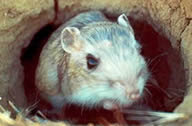The giant kangaroo rat is the largest species of kangaroo rats found in California. On average they grow to be between 12.3 and 13.7 inches long when including their exceptionally long tail. This species can be identified by their long tail, tiny forefeet, giant hind feet and large head. Like the pocket mice, which are similar to this species, the giant kangaroo rat stores seeds in the pockets in their cheeks to allow for easier transport. This species is nocturnal and is only active at night to search for food.
The habitat for the giant kangaroo rat is hot desert and dry grasslands. In California they live in the areas where temperatures often exceed 100 degrees Fahrenheit and receive less than 15 inches of rain each year. The soil in this habitat is often loose, easily diggable, and sandy which allows for easy burrowing. When the giant kangaroo rat isn't active, it spends the time in the underground burrow they've created. Giant kangaroo rats are very protective of their territory and possessions, in effort to keep away predators, this species drums its hind feet on the ground.
This species was listed on January 5, 1987 as being endangered at both the state of California level and national level. The giant kangaroo rat has become endangered due to the conversion of their habitat into agricultural uses and other modern developments. This has resulted in the fragmentation of six isolated populations of giant kangaroo rats in California.
Recently the amount of habitat conversion due to agriculture has slowed substantially. However the conversion of land due to mining, urban and industrial developments and other modern advances are still a threat to this species. In efforts to prevent further loss of the species, there has been research to determine whether or not giant kangaroo rats can thrive in the forest. There is also research being conducted to discover whether or not the Kern and San Luis Obispo counties if California would be suitable habitats for this species.
